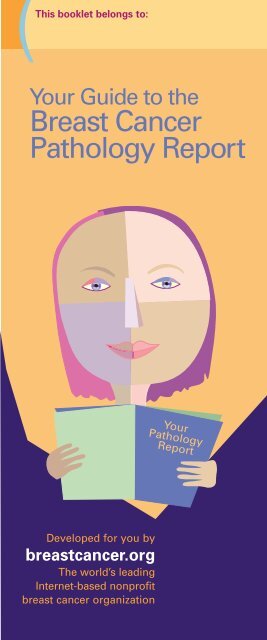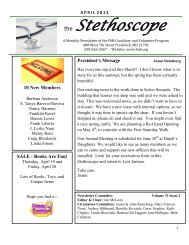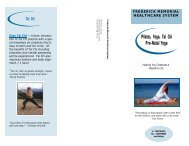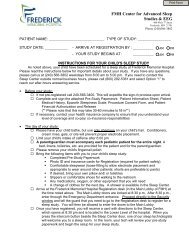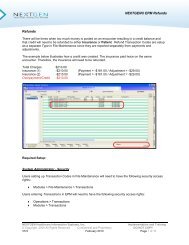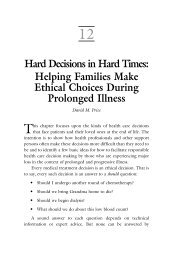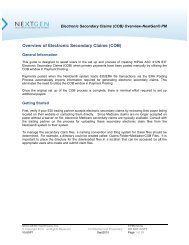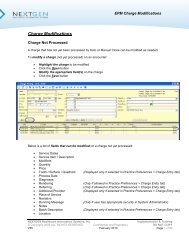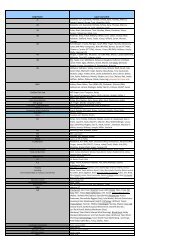Create successful ePaper yourself
Turn your PDF publications into a flip-book with our unique Google optimized e-Paper software.
(<br />
This booklet belongs to:<br />
Your Guide to the<br />
<strong>Breast</strong> <strong>Cancer</strong><br />
<strong>Pathology</strong> <strong>Report</strong><br />
Your<br />
<strong>Pathology</strong><br />
<strong>Report</strong><br />
Developed for you by<br />
breastcancer.org<br />
The world’s leading<br />
Internet-based nonprofit<br />
breast cancer organization<br />
For more information go to:<br />
For more information: www.breastcancer.org
Your Guide to the<br />
<strong>Breast</strong> <strong>Cancer</strong><br />
<strong>Pathology</strong> <strong>Report</strong><br />
A report is written each time that tissue<br />
is removed from the body to check for<br />
cancer. It is called a pathology report.<br />
Each report has the results of the<br />
studies of the tissue that was removed.<br />
The information in these reports will<br />
help you and your doctor decide about<br />
the best treatment for you.<br />
Reading your pathology report can be<br />
scary and confusing. The words are like<br />
a foreign language. Different labs may<br />
use different words to describe the same<br />
thing. On page 20, you’ll find an<br />
easy-to-understand word list.<br />
We hope we can<br />
help you make<br />
sense of this<br />
information so<br />
you can get the<br />
best care<br />
possible.<br />
Remember:<br />
No matter what the pathology report says<br />
about the cancer, there are many effective<br />
For treatments more information available go to deal to: with it.<br />
www.breastcancer.org
Table of Contents:<br />
Introduction<br />
Section A<br />
Section B<br />
Page 2 Wait for the Whole Picture<br />
Page 4 How to Start<br />
Page 5 Parts of Your <strong>Report</strong><br />
Page 6 The <strong>Breast</strong> <strong>Cancer</strong><br />
1. Is the tumor a cancer?<br />
2. Is the breast cancer invasive?<br />
3. How different are the cancer<br />
cells from normal cells?<br />
4. How big is the cancer?<br />
5. Has the whole cancer<br />
been removed?<br />
6. Are there cancer cells in<br />
your lymph or blood vessels?<br />
7. How fast are the cancer<br />
cells growing?<br />
8. Do the cancer cells<br />
have hormone receptors?<br />
9. Does the cancer have<br />
genes that are not normal?<br />
Page 18 The Lymph Nodes<br />
1. Are there breast cancer cells<br />
in your lymph nodes?<br />
2. How many lymph nodes<br />
are involved?<br />
Page 20 Word List<br />
Back Cover Key Questions
2<br />
Introduction:<br />
Wait for the Whole Picture<br />
Waiting is so hard! But just one test can lead<br />
to several different reports. Some tests take<br />
longer than others. Not all tests are done by<br />
the same lab. Most information comes within<br />
one to two weeks after surgery, and you will<br />
usually have all the results within a few<br />
weeks. Your doctor can let you know when<br />
the results come in. If you don’t hear from<br />
your doctor, give her or him a call.<br />
This is what the inside of a breast looks like:<br />
rib cage<br />
chest wall<br />
muscle<br />
This is what normal<br />
cells inside a milk duct<br />
look like under a microscope.<br />
fat<br />
lobules<br />
nipple<br />
ducts
Get All the Information You Need<br />
Be sure that you have all the test<br />
information you need before you make<br />
a final decision about your treatment.<br />
Also, don’t focus too much on any one<br />
piece of information by itself. Try to<br />
look at the whole picture as you think<br />
about your options.<br />
Different labs and hospitals may use<br />
different words to describe the same thing.<br />
If there are words in your pathology report<br />
that are not explained in this booklet, don’t<br />
be afraid to ask your doctor what they mean.<br />
<strong>Breast</strong> <strong>Cancer</strong> Stage<br />
The pathology report will help your<br />
doctor decide the stage of your breast<br />
cancer. It could be Stage 0, I (1), II (2),<br />
IIIA (3A), IIIB (3B), or IV (4).<br />
Staging is based on the size of the tumor,<br />
whether lymph nodes are involved, and<br />
whether the cancer has spread beyond the<br />
breast. Your doctors use all parts of the<br />
pathology report as well as the breast<br />
cancer stage to shape your treatment plan.<br />
For more information go to:<br />
www.breastcancer.org<br />
3
004<br />
Introduction:<br />
How to Start<br />
First, check the top of the report for your<br />
name, the date you had your operation,<br />
and the type of operation you had.<br />
Make sure they are right for you.<br />
Expert Tip:<br />
<strong>Pathology</strong> reports often come in bits and<br />
pieces. Just after surgery, the cancer cells<br />
are first looked at under the microscope.<br />
Results from additional studies that require<br />
special techniques may take longer. So you<br />
may have one, two, or three pathology<br />
reports from one surgery. Try to put them<br />
all together and keep them in one place,<br />
so that when you go for your treatment<br />
evaluations, the doctors will have all<br />
the information they need.<br />
– Marisa Weiss, M.D., breast cancer doctor
Parts of<br />
Your <strong>Report</strong><br />
Specimen. This section describes where<br />
the tissue samples came from. Tissue<br />
samples could be taken from the breast,<br />
from the lymph nodes under your arm<br />
(axilla), or both.<br />
Clinical history. This is a short description<br />
of you and how the breast abnormality<br />
was found. It also describes the kind of<br />
surgery that was done.<br />
Clinical diagnosis. This is the diagnosis<br />
the doctors were expecting before your<br />
tissue sample was tested.<br />
Gross description. This section describes<br />
the tissue sample or samples. It talks about<br />
the size, weight, and color of each sample.<br />
Microscopic description. This section<br />
describes the way the cancer cells look<br />
under the microscope.<br />
Special tests or markers. This section<br />
reports the results of tests for proteins,<br />
genes, and how fast the cells are growing.<br />
Summary or final diagnosis. This section is<br />
the short description of all the important<br />
findings in each tissue sample.<br />
For more information go to:<br />
www.breastcancer.org 5
6<br />
Section A:<br />
The <strong>Breast</strong> <strong>Cancer</strong><br />
1. Is the tumor a cancer?<br />
A tumor is an overgrowth of cells.<br />
It can be made of normal cells or cancer<br />
cells. <strong>Cancer</strong> cells are cells that grow in<br />
an uncontrolled way. They may stay in<br />
the place where they started to grow.<br />
Or they may grow into the normal<br />
tissue around them.<br />
The pathology report will tell you<br />
what kind of cells are in the tumor.<br />
2. Is the breast cancer invasive?<br />
The single most important fact<br />
about any breast cancer is<br />
whether it has grown beyond<br />
the milk ducts or lobules of<br />
the breast where it first started.<br />
Non-invasive<br />
Cells<br />
Non-invasive cancers stay<br />
within the milk ducts or milk<br />
lobules in the breast. They do<br />
not grow into or invade normal<br />
tissues within or beyond the<br />
breast. These are sometimes<br />
called in situ or pre-cancers.<br />
If the cancer has grown beyond where<br />
it started, it is called invasive.<br />
Most cancers are invasive.<br />
Sometimes cancer cells can<br />
also spread to other parts of<br />
the body through the blood<br />
or lymph system.<br />
Normal Cells<br />
Invasive<br />
Cells
You may see these<br />
descriptions of cancer<br />
in your report:<br />
DCIS (Ductal Carcinoma In Situ).<br />
This is a cancer that is not invasive. It stays<br />
inside the milk ducts.<br />
Note: There are subtypes of DCIS.<br />
You’ll find their names in the word list<br />
on page 20 of this booklet.<br />
LCIS (Lobular Carcinoma In Situ).<br />
This is a tumor that is an overgrowth of<br />
cells that stay inside the milk-making part<br />
of the breast (called lobules). LCIS is not<br />
a true cancer. It is a warning sign for an<br />
increased risk of having an invasive cancer<br />
in the future, in either breast.<br />
IDC (Invasive Ductal Carcinoma).<br />
This is a cancer that begins in the milk duct<br />
but grows into the surrounding normal tissue<br />
inside the breast. This is the most common<br />
kind of breast cancer.<br />
ILC (Invasive Lobular Carcinoma).<br />
This is a cancer that starts inside the<br />
milk-making glands (called lobules), but<br />
grows into the surrounding normal tissue<br />
inside the breast.<br />
Note: There are other, less common types of<br />
invasive breast cancer. You’ll find their names<br />
in the word list on page 20 of this booklet.<br />
(<br />
My report says:<br />
I have the _____________________________<br />
type of cancer.<br />
For more information go to:<br />
www.breastcancer.org<br />
7
Section A:<br />
The <strong>Breast</strong> <strong>Cancer</strong><br />
3. How different are the cancer<br />
cells from normal cells?<br />
Experts call this “grade.” They compare<br />
cancer cells to normal breast cells. Based<br />
on these comparisons, they give a<br />
“grade” to the cancer.<br />
There are three<br />
cancer grades:<br />
Grade 1<br />
(Low Grade or Well Differentiated):<br />
Grade 1 cancer cells still look a lot<br />
like normal cells. They are usually<br />
slow-growing.<br />
Grade 2<br />
(Intermediate/Moderate Grade<br />
or Moderately Differentiated):<br />
Grade 2 cancer cells do not look like<br />
normal cells. They are growing<br />
somewhat faster than normal cells.<br />
Grade 3<br />
(High Grade or Poorly Differentiated):<br />
Grade 3 cancer cells do not look at all<br />
like normal cells. They are fast-growing.<br />
( My report says the cancer is: (circle one)<br />
Grade 1 Grade 2 Grade 3<br />
8
3 cm<br />
1cm<br />
4. How big is the cancer?<br />
5 cm<br />
2 inches<br />
1cm 2cm 3cm 4cm 5cm<br />
Doctors measure cancers in centimeters<br />
(cm). The size of the cancer helps to<br />
determine its stage.<br />
Size doesn’t tell the whole story. Lymph<br />
node status is also important. A small<br />
cancer can be very fast-growing. A larger<br />
cancer can be a “gentle giant.”<br />
( My report says:<br />
The size of the cancer is _______ centimeters.<br />
For more information go to:<br />
www.breastcancer.org 9
10<br />
Section A:<br />
The <strong>Breast</strong> <strong>Cancer</strong><br />
5. Has the whole cancer<br />
been removed?<br />
When cancer cells are removed from<br />
the breast, the surgeon tries to take out<br />
the whole cancer with an extra area or<br />
“margin” of normal tissue around it.<br />
This is to be sure that all of the<br />
cancer is removed.<br />
The tissue around the very edge of what<br />
was removed is called the margin of<br />
resection. It is looked at very carefully<br />
to see if it is clear of cancer cells.<br />
The pathologist also measures the<br />
distance between the cancer cells<br />
and the outer edge of the tissue.<br />
Note: What is called “negative”<br />
(or “clean”) margins can be different<br />
from hospital to hospital. In some places,<br />
doctors want at least two millimeters<br />
(mm) of normal tissue beyond the edge<br />
of the cancer. In other places, just one<br />
healthy cell is called a negative margin.<br />
1 mm<br />
1 cm<br />
1 inch
Margins around a cancer<br />
are described in<br />
three ways:<br />
Negative:<br />
No cancer cells can be seen at the outer edge.<br />
Usually, no more surgery is needed.<br />
Positive:<br />
<strong>Cancer</strong> cells come right out to the edge of the<br />
tissue. More surgery may be needed.<br />
Normal tissue<br />
<strong>Cancer</strong> cells<br />
The edge<br />
The edge<br />
<strong>Cancer</strong> cells<br />
Close:<br />
<strong>Cancer</strong> cells are close to the edge of the tissue,<br />
but not right at the edge. More surgery may<br />
be needed.<br />
( Negative Positive Close<br />
Normal tissue<br />
My report says the margins are: (circle one)<br />
For more information go to:<br />
www.breastcancer.org<br />
11
12<br />
Section A:<br />
The <strong>Breast</strong> <strong>Cancer</strong><br />
6. Are there cancer cells in your<br />
lymph or blood vessels?<br />
The breast has a network of blood<br />
vessels and lymph channels that connect<br />
breast tissue to other parts of the body.<br />
These are the “highways” that bring in<br />
nourishment and remove waste products.<br />
There is an increased risk of cancer<br />
coming back when cancer cells are found<br />
in the fluid channels of the breast. In<br />
these cases, your doctor may recommend<br />
treatment to your whole body, not just<br />
the breast area.<br />
This test result will look like this:<br />
Lymphatic/vascular invasion:<br />
PRESENT (yes, it has been found) or<br />
ABSENT (no, invasion not found).<br />
(<br />
My report says lymphatic<br />
or vascular invasion is: (circle one)<br />
Present Absent
7. How fast are the<br />
cancer cells growing?<br />
(Rate of Growth)<br />
There are two tests that may be used<br />
to see how fast the cancer is growing:<br />
S-phase fraction test and Ki-67 test. Both<br />
tests measure if the cells are growing at a<br />
normal rate or faster than normal.<br />
Even in very experienced labs, these tests<br />
are hard to do reliably. That’s why many<br />
doctors depend on other information to<br />
make the best treatment decisions.<br />
For more information go to:<br />
www.breastcancer.org<br />
13
14<br />
Section A:<br />
The <strong>Breast</strong> <strong>Cancer</strong><br />
8. Do the cancer cells have<br />
hormone receptors?<br />
Hormone receptors are like ears on<br />
breast cells that listen to signals from<br />
hormones. These signals “turn on”<br />
growth in breast cells that have<br />
receptors.<br />
A cancer is called “ER-positive”<br />
if it has receptors for the hormone<br />
estrogen. It is called “PR-positive”<br />
if it has receptors for the hormone<br />
progesterone. <strong>Breast</strong> cells that do<br />
not have receptors are “negative”<br />
for these hormones.<br />
<strong>Breast</strong> cancers that are either ER-positive<br />
or PR-positive, or both, tend to respond<br />
well to hormone therapy.<br />
These cancers can be treated with<br />
medicine that reduces the estrogen in<br />
your body. They can also be treated<br />
with medicine that keeps estrogen<br />
away from the receptors.<br />
If the cancer has no hormone receptors,<br />
there are still very effective treatments<br />
available.
You will see the results<br />
of your hormone receptor<br />
test written in one of these<br />
three ways:<br />
1) the number of cells that have<br />
receptors out of 100 cells tested.<br />
You will see a number between<br />
0% (no receptors) and 100%<br />
(all have receptors).<br />
2) a number between 0 and 3.<br />
You will see the number<br />
• 0 (no receptors),<br />
• 1+ (a small number),<br />
• 2+ (a medium number), or<br />
• 3+ (a large number of receptors).<br />
3) the word “positive” or “negative.”<br />
Note: If your report just says “negative,”<br />
ask your doctor or lab to give you a<br />
number. This is important because<br />
sometimes a low number may be called<br />
“negative.” But even cancers with low<br />
numbers of receptors may respond to<br />
hormone therapy.<br />
(<br />
My report says<br />
hormone receptors are: (circle two)<br />
ER-positive ER-negative<br />
PR-positive PR-negative<br />
For more information go to:<br />
www.breastcancer.org<br />
15
16<br />
Section A:<br />
The <strong>Breast</strong> <strong>Cancer</strong><br />
9. Does the cancer have<br />
genes that are not normal?<br />
HER-2 status<br />
(also called HER-2/neu)<br />
HER-2 is a gene that helps control how<br />
cells grow, divide, and repair themselves.<br />
About one out of four breast cancers has<br />
too many copies of the HER-2 gene. The<br />
HER-2 gene directs the production of<br />
special proteins, called HER-2 receptors,<br />
in cancer cells.<br />
<strong>Cancer</strong>s with too many copies of the<br />
HER-2 gene or too many HER-2<br />
receptors tend to grow fast. They are<br />
also associated with an increased risk of<br />
spread. But they do respond very well<br />
to treatment that works against HER-2.<br />
This treatment is called anti-HER-2<br />
antibody therapy.<br />
(<br />
My report says HER-2 status is:<br />
(circle one) Positive Negative<br />
Test used:<br />
(circle one) IHC FISH
There are two<br />
tests for HER-2:<br />
1) IHC test<br />
(IHC stands for ImmunoHistoChemistry)<br />
• The IHC test shows if there is too<br />
much HER-2 receptor protein in<br />
the cancer cells.<br />
• The results of the IHC test can be<br />
0 (negative), 1+ (negative),<br />
2+ (borderline), or 3+ (positive).<br />
2) FISH test<br />
(FISH stands for Fluorescence In Situ Hybridization)<br />
• The FISH test shows if there are too<br />
many copies of the HER-2 gene in<br />
the cancer cells.<br />
• The results of the FISH test can<br />
be “positive" (extra copies) or<br />
“negative” (normal number of copies).<br />
Find out which test for HER-2 you had.<br />
This is important. Only cancers that test<br />
IHC “3+” or FISH “positive” will respond<br />
well to therapy that works against HER-2.<br />
An IHC 2+ test result is called borderline.<br />
If you have a 2+ result, you can and<br />
should ask to have the tissue tested<br />
with the FISH test.<br />
For more information go to:<br />
www.breastcancer.org 17
18<br />
Section B:<br />
The Lymph Nodes<br />
1. Are there breast cancer<br />
cells in your lymph nodes?<br />
Having cancer cells in the lymph nodes<br />
under your arm is associated with an<br />
increased risk of the cancer spreading.<br />
Lymph nodes are filters along the<br />
lymph fluid channels. Lymph fluid<br />
leaves the breast and goes back into<br />
the bloodstream. The lymph nodes<br />
try to catch and trap cancer cells before<br />
they reach other parts of the body.<br />
When lymph nodes are free or “clear”<br />
of cancer, the test results are called<br />
“negative.” If lymph nodes have some<br />
cancer cells in them, they are called<br />
“positive.”<br />
(<br />
My report says the lymph nodes are:<br />
(circle one) Positive Negative<br />
If positive:<br />
The number of involved nodes is _____.
2. How many lymph nodes<br />
are involved?<br />
The more lymph nodes have cancer<br />
cells in them, the more serious the cancer<br />
might be. For this reason, doctors use<br />
the number of involved lymph nodes<br />
to help make treatment decisions.<br />
Doctors also look at the amount of<br />
cancer in the lymph nodes.<br />
You may see these words<br />
describing how much cancer<br />
is in each lymph node:<br />
microscopic:<br />
Only a few cancer cells are in the node.<br />
A microscope is needed to find them.<br />
gross:<br />
There is a lot of cancer in the node. You can<br />
see or feel the cancer without a microscope.<br />
extracapsular extension:<br />
<strong>Cancer</strong> has spread outside the wall of<br />
the node.<br />
For more information go to:<br />
www.breastcancer.org 19
00 20<br />
Word List<br />
Abnormal cells: cells that<br />
do not look or act like the<br />
healthy cells of the body<br />
Aggressive cancer cells:<br />
cells that are fast-growing<br />
and can spread beyond the<br />
area where they started<br />
Anti-HER-2 antibody<br />
therapy: a medicine used<br />
to treat breast cancer with<br />
abnormal HER-2 genes<br />
Aromatase inhibitor:<br />
medicine that reduces<br />
estrogen in the body<br />
(after menopause)<br />
Axillary lymph nodes:<br />
lymph nodes under<br />
your arms<br />
Benign: not cancerous<br />
Biopsy: an operation to<br />
take out tissue to check<br />
if it is cancer or not<br />
Clean margins: means<br />
that the normal tissue<br />
around the tumor is<br />
free of cancer cells<br />
Close margins: means<br />
that cancer cells come<br />
near the outer edge of the<br />
tissue around the tumor<br />
Colloid: a type of invasive<br />
cancer that grows into the<br />
normal tissue around it;<br />
it usually grows slowly<br />
Comedo: a type of<br />
non-invasive cancer that<br />
usually does not spread;<br />
it tends to grow fast<br />
Cribriform: a type of<br />
non-invasive cancer that<br />
does not spread and<br />
usually grows slowly<br />
Ductal Carcinoma<br />
In Situ (DCIS):<br />
a non-invasive cancer that<br />
stays inside the milk pipes<br />
and usually doesn’t spread<br />
ER-negative: a cancer<br />
that does not have<br />
estrogen receptors<br />
ER-positive: a cancer that<br />
has estrogen receptors<br />
FISH (Fluorescence In<br />
Situ Hybridization) test:<br />
a test for the HER-2 gene<br />
Gene: part of the body’s<br />
code for making new cells<br />
and controlling the growth<br />
and repair of the cells<br />
Grade: tells you how<br />
much the tumor cells look<br />
different from normal cells<br />
HER-2: a gene that helps<br />
control the growth and<br />
repair of cells<br />
Hormone receptors: tiny<br />
areas like ears on cells<br />
that listen and respond to<br />
signals from hormones<br />
IHC (immunohistochemistry)<br />
test: a test<br />
for the HER-2 protein<br />
In situ: a cancer that<br />
stays inside the part of the<br />
breast where it started;<br />
it usually does not spread<br />
Invasive: a cancer that<br />
spreads beyond the<br />
place where it started<br />
Invasive Ductal<br />
Carcinoma (IDC): a<br />
cancer that begins in the<br />
milk duct but grows into<br />
the normal breast tissue<br />
around it<br />
Invasive Lobular<br />
Carcinoma (ILC): a<br />
cancer that starts inside<br />
the milk-making gland,<br />
but grows into the normal<br />
breast tissue around it<br />
Irregular cells: cells that<br />
do not look like the<br />
healthy cells of the body
Ki-67 Test: a test that<br />
shows how fast cancer is<br />
growing<br />
Lobular Carcinoma In<br />
Situ (LCIS): cells that are<br />
not normal but that stay<br />
inside the milk-making<br />
part of the breast<br />
Lymphatic invasion:<br />
means that cancer cells are<br />
found in the lymph vessels<br />
Lymph nodes: filters<br />
along the lymph fluid<br />
channels; they try to catch<br />
and trap cancer cells<br />
before they reach other<br />
parts of the body<br />
Margins: the normal<br />
tissue around the tumor<br />
that was taken out<br />
Medullary: a type of<br />
invasive cancer that grows<br />
into the normal tissue<br />
around it<br />
Milk ducts: tiny tubes in<br />
the breast through which<br />
milk flows to the nipple<br />
Milk lobules: milkmaking<br />
glands in the<br />
breast<br />
Mucinous: a type of<br />
invasive cancer that<br />
spreads into the normal<br />
tissue around it<br />
Negative margins:<br />
means that the tissue<br />
around the tumor is free<br />
of cancer cells<br />
Non-invasive: a cancer<br />
that stays inside the breast<br />
part where it started<br />
Papillary: a type of<br />
non-invasive cancer<br />
that does not spread and<br />
tends to grow slowly<br />
Pathologist: a doctor<br />
who looks at tissue under<br />
a microscope to see if it’s<br />
normal or affected by<br />
disease<br />
Positive margins: means<br />
that cancer cells come up<br />
to the edge of the normal<br />
tissue around the tumor<br />
Pre-cancerous: a tumor<br />
that is not considered a<br />
cancer; it is a warning sign<br />
that you may get cancer in<br />
the future<br />
PR-negative: a cancer<br />
that does not have<br />
progesterone receptors<br />
PR-positive: a cancer that<br />
has progesterone receptors<br />
Recurrence: when a<br />
cancer comes back again<br />
Solid: a type of cancer<br />
that is non-invasive; it<br />
does not spread and tends<br />
to grow slowly<br />
S-phase fraction test: a<br />
test that shows how fast a<br />
cancer is growing<br />
Tamoxifen: medicine that<br />
stops estrogen from<br />
reaching hormone<br />
receptors on cancers<br />
Tubular: a type of invasive<br />
cancer that grows into the<br />
normal tissue around it;<br />
it usually grows slowly<br />
Vascular invasion: means<br />
that cancer cells are found<br />
in the blood vessels<br />
For more information go to:<br />
www.breastcancer.org 21
Tell us what you think<br />
Just fill in, tear off, and mail — no stamp required.<br />
00<br />
Thank you for taking the time to<br />
answer these questions.<br />
My age: ■ 18-30 ■ 31-40 ■ 41-50 ■ 51-60<br />
■ 61-70 ■ 71-80 ■ 81-100<br />
I am a: ■ Woman affected by breast cancer<br />
■ Family member/friend<br />
■ Physician ■ Nurse<br />
■ Other health care professional<br />
I would like more of these booklets to give to others:<br />
■ Yes ■ No If yes, how many? ________________<br />
Mailing address:_________________________________<br />
________________________________________________<br />
I would like to receive free email updates from<br />
breastcancer.org: ■ Yes ■ No<br />
Email address: __________________________________<br />
Questions for women affected by breast cancer:<br />
1. Did this booklet help you to understand your breast cancer<br />
pathology report? ■ A lot ■ A little ■ Not at all<br />
2. Did this booklet give you more confidence in talking<br />
to your doctor about breast cancer?<br />
■ A lot ■ A little ■ Not at all<br />
3. Did this booklet help you think of questions to<br />
ask your doctor? ■ A lot ■ A little ■ Not at all<br />
4. Did this booklet help you in making decisions about your<br />
treatment? ■ A lot ■ A little ■ Not at all<br />
5. Do you use the Internet to find information about<br />
your health? ■ A lot ■ A little ■ Not at all<br />
Questions for health care professionals:<br />
1. Has this booklet helped facilitate your discussions with<br />
patients about their treatment options?<br />
■ A lot ■ A little ■ Not at all<br />
2. Do you feel this booklet has helped save you time in your<br />
discussions with your patients?<br />
■ A lot ■ A little ■ Not at all<br />
3. Do you feel this booklet has helped make your patients<br />
more comfortable with their treatment decisions?<br />
■ A lot ■ A little ■ Not at all
Key Questions<br />
Here are important questions to be sure<br />
you understand, with your doctor’s help:<br />
1. Is this breast cancer invasive<br />
or non-invasive?<br />
2. Are any lymph nodes involved<br />
with cancer? If so, how many?<br />
3. What did the hormone receptor test<br />
show? Can you take a medicine that<br />
lowers or blocks your estrogen?<br />
4. Were the margins negative,<br />
close, or positive?<br />
5. Was the HER-2 test normal<br />
or abnormal?<br />
6. Is this a slow-growing or a<br />
fast-growing breast cancer?<br />
7. What other lab tests were<br />
done on the tumor tissue?<br />
8. What did these tests show?<br />
9. Is any further surgery recommended<br />
based on these results?<br />
10. What types of treatment are most<br />
likely to work for this specific cancer?<br />
“To help women and their loved ones make sense<br />
of the complex medical and personal information<br />
about breast cancer, so they can make the best<br />
decisions for their lives.”<br />
This booklet was made possible by an unrestricted<br />
educational grant from<br />
and funding from the<br />
For more information go to:<br />
www.breastcancer.org<br />
©breastcancer.org 2003<br />
00<br />
PUB1REV0603GC


